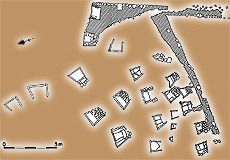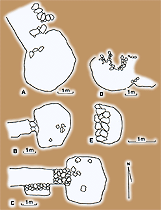The burial customs of the Bronze Age in the Aegean differ from one region to another and from one period to another. They provide very important evidence on the demography, the social composition and the beliefs of the prehistoric islanders on life after death. During the Early Bronze Age in the Cyclades cemeteries with small cist graves and chamber tombs in clusters for the inhumation of different families were used. The position of the graves is indicated by a stone-built stele (platform) while there are signs in some cemeteries (Agioi Anargyroi on Naxos) indicating that funeral ceremonies took place. The dead were buried in a contracted position with their most important personal articles (jewellery, figurines, weapons, etc.) which accompanied them in their life after death. In the north and eastern Aegean islands isolated burials of infants and children within the limits of the settlement, in vases or simple pits which are dug for this reason into the floors of houses, occur (Poliochni, Thermi, Heraion). Adults are buried obviously out of the limits of the settlement, in cemeteries which have not yet been found and they included burials most likely in simple pits or in pithoi. During the Middle Bronze Age in the Cyclades the use of cemeteries beyond the limits of the large settlements continues. Burials in simple or cist graves, chamber tombs and pithoi take place. The marking of the graves with stone platforms survives in this period as well. The discovery of a cist grave and ritual platform in a building at Agia Irini on Keos is noteworthy. The burial finds from the other Aegean islands are poor. In the course of the Late Bronze Age, a period of gradual expansion of the Mycenaean power on the Aegean islands, burial customs known from Mycenaean Greece are adopted at a small or large degree, depending on the region. The cist grave disappears in the Late Cycladic I (Ailas on Naxos) and now vaulted chamber tombs prevail in the cemeteries (Aplomata, Kamini and Grotta on Naxos). At the same time, isolated examples of shaft graves (Phylakopi) and tholos tombs (Agia Thekla on Tinos) occur from the Late Cycladic IIIB period. The collection and the burials rich in grave-goods including jewellery, weapons, Mycenaean figurines and vases complete the picture of the burial customs of the end of the Bronze Age.
|
 |
|
|
Naxos, Agioi Anargyroi.
Plan of the Early Cycladic cemetery. |
||
 |
||
|
Naxos, Kamini. Plans of chamber tombs.
Late Bronze Age. |
||